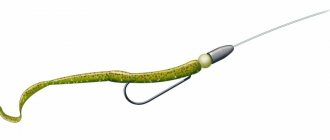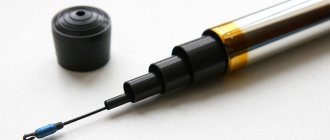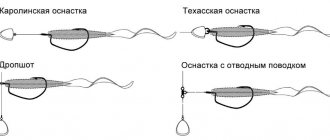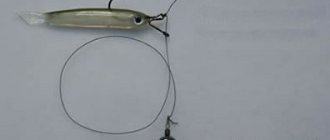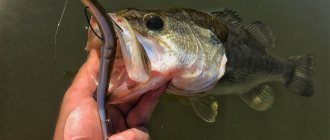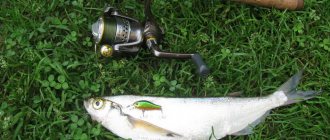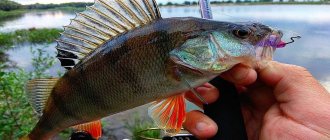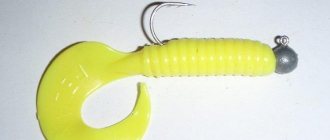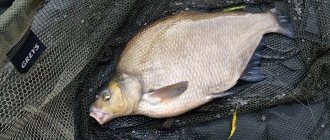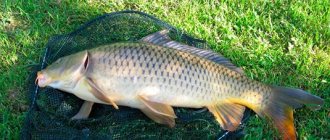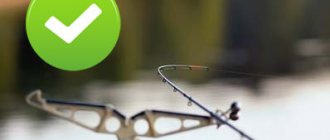What is Carolina
Caroline is a type of catching tackle in which a leash (an extension of the main fishing line) is mounted between the sinker and the bait. The method was invented by the Americans. For the first time, they began to catch bass in thickets and snags using a Carolina hook.
The tackle exhibits excellent performance in difficult conditions (shell rocks, stones, grass thickets), bottom layers of water. Where other spaced analogues (drop-shot, retractable leash, Texas rig) are unsuitable for hunting.
Installation
Despite its complex appearance, making Carolina rigs is quite easy to master even for a novice angler.
For installation you will need:
- Sliding sinker. A weight with a hole in the center can be of any shape, but this installation is usually equipped with a cone-shaped bullet weight.
- Bead. The color in this case does not matter; this part of the equipment serves, to a greater extent, as a stopper for the sinker.
- Swivel. Serves to separate the sinker from the leash and also prevents the latter from twisting.
- Leash made of monofilament or fluorocarbon.
- Offset hook.
- Silicone bait.
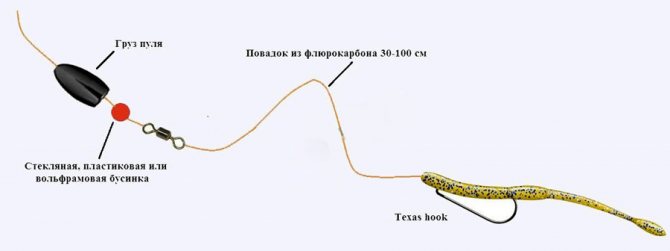
Installation of Carolina rigging is quite simple, which is why even in the event of a complete break or cut, the rigging can be quickly restored.
The choice of size and weight of elements largely depends on the characteristics of the reservoir, as well as on the type of predator that needs to be caught. Installation of this equipment is carried out as follows:
- The main braided cord is threaded into the hole of the sliding sinker and passed through it.
- A bead is placed on the main braid.
- A swivel is attached to the edge of the cord, preventing the weight and bead from slipping. The most convenient way is to use the classic Palomar knot.
- A monofilament leash is tied to the free eye of the swivel. The length of the leash can vary, from 15 centimeters to several meters, but usually, as the most universal, a length of 80–100 centimeters is used.
- An offset hook is mounted on the end of the leash. The hook size is selected based on the expected size of the predator.
- The hook is equipped with a silicone bait of the required size.
In this simple way you can get a Carolina rig. With the right elements, such an installation will seduce any predator.
Advantages and disadvantages
Today there are various silicone edible baits on the market.

The undeniable advantages of the Carolina equipment:
- high passability through any obstacles, hard-to-reach places;
- the ability to catch fish in shallow water or near the bottom, while other models work only 20-30 cm above the bottom;
- suitability for the use of different types of wiring, taking into account the terrain and fishing conditions;
- ease of use of any silicone baits, taking into account the degree of activity of predatory fish and fishing conditions;
- 100% catchability even for passive fish;
- accessibility of all equipment elements;
- performance on the floodplain of pike, perch, pike perch, burbot, asp, catfish;
- perfect aerodynamic characteristics;
- ease of installation;
- affordable price.
The disadvantages are that the equipment is suitable for raiding exclusively near-bottom areas. When fishing in the current, the Carolina fish is ineffective with little ability to pass through obstacles.
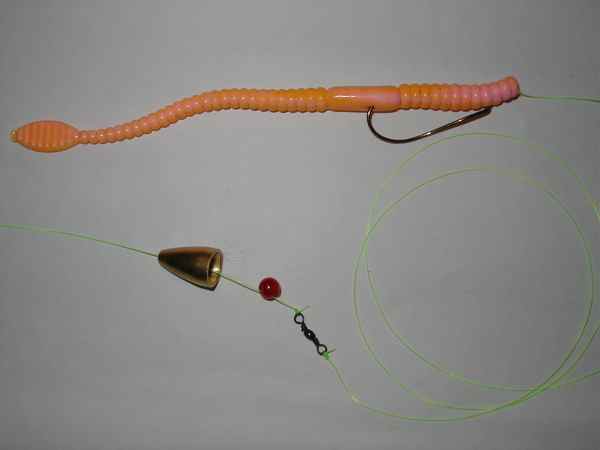
Reference!
The equipment works well on reservoirs with non-snappy hooks. The best bait option is passive or active plastic worms.
Carolina rig video
Friends, for those who are too lazy to read this text, we offer a short video in which you will find all the answers to questions about the “Carolina equipment”.
And here’s another simple and clear video about how to attach such equipment. Step by step, so to speak!
PS In conclusion, I would like to say that there is no ideal equipment for fishing, there is only the right one chosen for certain conditions. “Carolina rig” is not a panacea, it will not provide you with 100% success, but if used correctly, it can surprise and delight you with excellent fishing.
What's included in the equipment
Carolina looks like a sinker and a leash with bait on an offset hook sliding along the main line. For shock absorption, a bead is mounted between the sinker and the leash.
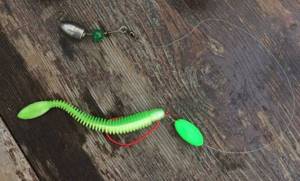
The equipment includes:
- A sliding sinker in the shape of a bullet or drop with an axial hole. The bullet weight is made of brass or bronze, so it easily slides through the stems of aquatic vegetation, branches of flooded trees or shell rock, attracting the attention of predatory fish. If you wish, you can cast the bullet yourself, for example, from lead. Although a tungsten or bronze bullet-shaped weight is better, it passes flawlessly through strong places and makes characteristic sounds on the water to lure predatory individuals.
- Leash . A monofilament line or a piece of fluorocarbon (30-60 cm) is suitable for it. When fishing at the bottom of a reservoir with snags or sharp stones, it is better to choose a thick nylon leash, because The monofilament will quickly get tangled or break.
- Hooks . Offsets are used. The size is selected taking into account the length of the selected bait. An important condition is strength, so that the equipment does not get tangled, and the predator does not go into cover during forced fishing.
- Swivel . Serves as a stopper for the sliding sinker and an anti-twist of the leash. To avoid clinging to branches and algae, it is better to choose the smallest size. As a shock absorber, there is a metal glass bead that protects the connection between the leash and the cord, creating a noise effect when it hits the sinker at the time of wiring.
Installation elements
Let's look at the components of the Carolina spinning rig.

fishing line
As a rule, braided cord is always used as the main fishing line. If you don’t have braid, you can use monofilament fishing line, but it has many significant disadvantages, so it can only be used as a last resort.
If fishing is carried out in places where shell rock accumulates, then it is advisable to tie a leash (up to 0.5 meters) made of fluorocarbon before rigging, since braid is subject to abrasion faster than fluorocarbon from direct contact with the bottom.
Sinker
The classic cargo shape for Carolina is the “bullet”. Although, unlike in Texas, the shape of the weight may be different. For example, “olive” or “drop”. The main thing is that it is oblong.
To make a sinker the following is used:
- lead. Lead weights are extremely popular among fishermen due to the fact that they can be made independently. A significant disadvantage is that the sound produced when the weight hits the bead is very weak;
- brass. Unlike lead weights, brass weights make a noticeable click. They are quite light, and therefore suitable for fishing in shallow water areas with standing water;
- tungsten. Such weights are characterized by significant weight with a small volume, in addition, they are as “loud” as brass weights. They are difficult to obtain and, moreover, their price is high;
- bronze. In terms of their parameters, bronze weights resemble tungsten weights. The disadvantages are similar.
The weight of the sinkers depends on the fishing conditions, and more specifically on the speed of the current and the depth at the fishing spot. Usually in our reservoirs for Carolina they take weights weighing 21 and 28 grams. These weights are enough to effectively drag the bait along the bottom without losing control over it. Such weights can be used both in shallow water and at considerable depth. If necessary, the weight of the sinker can be increased to 40 grams.
Leash
The choice of material for the leash is determined by the nature of the bottom. On a clean bottom, you can make a leash from monofilament fishing line, but in places with shell rock and sharp stones, there is practically no alternative to fluorocarbon. He is so critical of mechanical damage.
The leash size varies from 0.3m to 1m depending on the activity of the predator. The thickness of the leash is determined by the fishing depth and the size of the expected catch.
In addition to fluorocarbon, steel, tungsten and titanium leashes are often used for pike hunting. Pike are not able to bite through them, unlike fluorocarbon, but the number of bites will be significantly reduced. When hunting for pike perch and pike perch, the use of such leashes is not advisable.
Bead
The bead performs two main functions. First of all, it is a damper that protects the knot on the hook from the sinker. The second function is the creation of acoustic vibrations arising from the impact of a weight on a bead.
To obtain the greatest noise effect that attracts a predator, it is advisable to take a bead made of brass, tungsten or glass. The bead must be quite massive in order to produce an extremely loud sound when struck. In addition, it is important that it can slide freely along the main line.
Glass beads often break, brass and tungsten ones are difficult to find, so anglers prefer to use plastic beads.
Hooks
Both regular hooks and offset hooks are suitable for fishing places with a clean bottom. There is no point in covering the point of the hook in this case. For places with a high probability of snagging, offsets are the best choice. Thanks to their balance, they move with the tip upward when inserted. The hook size is chosen based on the size of the intended trophy.
For elongated, narrow-bodied lures, offset Texas hooks are best suited. Volumetric baits are designed for use in combination with Wide Gap offset baits.
Swivel
The swivel is necessary for attaching the main line and the leash; in addition, it prevents the line from getting tangled during wiring. It is recommended to take strong, high-quality swivels from well-known manufacturers, otherwise it may not withstand the fight against a predator. The size of the swivels is also very important; the smaller it is, the less likely it is to get caught.
Carolina installation
There are different manufacturing options that fishermen use, taking into account the specifics of catching areas.
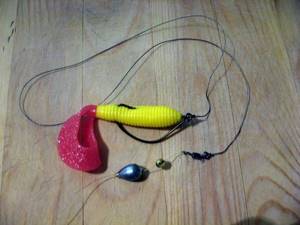
The simplest is basic installation:
- string a bead and sinker onto a braided fishing line;
- tie the swivel with a palamar or clinch knot;
- tie a piece of nylon or fluorocarbon to a free loop;
- tie an offset hook to the end of the leash;
- fix the bait on the offset, hiding the body in the hook tip.
Advice!
To increase the abrasive properties and reliability of the Carolina equipment, it is recommended to install an intermediate leash 35 cm long between the section with the bait and the braid, on which to put a bullet weight.
Texas and Carolina baits
Usually I catch small grass perch weighing up to 200-250 g. The fishing area is replete with various obstacles in the form of grass, stones, snags, in which baits intended for perch are caught with enviable consistency. When a reasonable number of breaks on dead hooks occur during a fishing trip (say, three to five), it may not be worth using special equipment. But when there are seven or eight dead hooks per ten casts or the bait collects grass immediately after splashdown, it makes sense to resort to special rigs.
How justified is the sinker – “bullet”?
In the practice of spinning anglers, it often happens that a passive perch does not respond to either a wobbler or a “spinner”, but a microjig bait with a pronounced bottom wiring can provoke it to bite. If the bottom is relatively clean, you can limit yourself to simple mounts on classic jig heads or sinkers— Cheburashkas, but in the presence of the above-mentioned pubic interference, such equipment gets caught very often, and fishing is unlikely to be enjoyable.
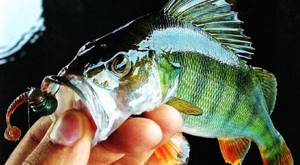
My microjigging practice has shown that when using a rig with a sinker-spool in a heavily overgrown water area, there are practically no dead hooks and the bait is “clogged” with vegetation 80% less than a classic rig. When fishing on a rocky bottom, the statistics are less positive, because most often the sinker itself gets jammed between the stones (including bullet-shaped ones), but in comparison with a spherical sinker, the percentage of bait losses is significantly lower. Most of the reservoirs in the Southern Urals where I fish are located in mountainous areas, and the reservoirs usually have a rocky bottom. And the coastal dump is generally a solid “rock”. I remember a typical case when, on ten hooks with a classic rig, within 10-15 m from the coastline, I had ten “dead” hooks. The wiring that I used then was a classic “step” with minimal contact with the bottom when paused. But this didn’t help either.
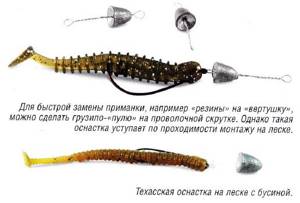
"Texas" or "Carolina"?
The differences in design between Texas and Carolina rigs are minor. They consist in the fact that in “Carolina” the hook with bait and sinker are separated by a leash, and in “Texas” the bait goes immediately behind the sinker. The area of application of the “Texas” is shallow depths and thickets of grass, hence the use of lighter weights. “Carolina” is most often used on rocky bottoms and at greater depths, which means a larger mass is required. In the microjig version, the weight rarely exceeds 3 g, and often amounts to 1-1.5 g.
Read: Jig - head and hook
One of the features of the original equipment (most often “Carolina”), invented for bass fishing, is a bullet sinker made of brass or bronze, as well as a faceted glass bead. The sinker and the bead move freely along the line and, touching during retrieval, produce noise, which should additionally attract fish. For us, the noise properties of the equipment are less interesting than “all-terrain” ones, and it’s unlikely that we can get special brass weights anywhere. But this is not scary, because sinkers of such a popular shape as the “olive” are very common in domestic stores, and with simple manipulations with a knife, paper clip and drill, from one olive you can get two “bullets” that completely meet our needs.
"Texas". When installing the “Texas”, I use a small bead of a contrasting color with the bait, initially trying to create some semblance of the original equipment. In combination with a lead bullet, this part can hardly create any audible sound effect, but it does provide an aiming point. In addition, after observing the movement of the equipment in the water during stepwise retrieval, I noticed a very interesting resemblance to a fry that catches an edible particle sinking to the bottom. You can experiment with the color of the beads, as in a reelless jig. Changing only the color of the bead without changing the bait itself sometimes greatly affects the result, although there are different opinions.
"Caroline". In the original Carolina rig, the bead with the bait are separated, and the role of the stopper is played by a swivel, to which the leash with the bait is attached. In our case, the rig is light, and instead of a swivel on a leash, the sinker is secured with a bead, into which the fishing line is threaded several times. In my opinion, this is more convenient than tying a leash to a swivel, much more compact and mobile: depending on the conditions, you can adjust the length of the leash.
In classic Carolina, fluorocarbon or monofilament is used as the main line, and the equipment is mounted on them. But for microjig, it is more appropriate to use a “braid” with a fluorocarbon leash 1-1.5 m long for Texas and 1.5-2 m for Carolina, connected to each other with a carrot or double uni knot.
The large length of the leash in “Carolina” in this case is due to the fact that approximately half the length is the leash from hook to sinker, and the rest acts as insurance against tangling or damage to the line by the sinker. Fluorocarbon was initially positioned as a material with the same light refractive index as water, but much more important is its abrasion resistance and somewhat greater rigidity than monofilament. All these properties are very useful: the equipment gets tangled less and is less likely to be injured by stones, since the wiring is mostly bottom-based. The tensile strength of the cord is no more than 4-6 lb (1.8-2.7 kg), the color should be noticeable in different lighting conditions, since the wiring is practically not felt in the hand and visual control is important.
Read: Fishing for pike perch on small rivers
"Rubber"
As for baits, worm-like “rubber” is more suitable for such fishing. I also used classic twisters quite successfully. Anything that can be put on an offset hook will do. In this case, most often “edible rubber” gives the best result. The offset hook is the only type of hook that is applicable in this fishing method, since the “bullet” does not allow the bait to be oriented in the water clearly in one plane and initially a non-snaking hook is needed. Its shape should be selected for a specific type of bait, fishing conditions and fish activity. When the bite is bad, replacing the hook with a smaller one often helps, of course, to the detriment of the number of bites, but in favor of their number.
A lot has been said and written about color, and opinions vary. I don’t see the point in advising anything specific, since even I have used baits of different colors in different bodies of water, and it is difficult to identify any consistency, so it is advisable to select the optimal color for specific conditions.
Tactics and technique
If in the fishing area there is some kind of promising, from my point of view, “interference” in the form of a snag or a tuft of grass, then I will try to process it with the first casts. This pattern is more typical either for overgrown reservoirs or for not very large ones. After processing promising areas with fan casts, I fish the rest of the water area. The fan pattern is used in places where there are no or invisible specific objects that the perch may gravitate towards. For example, on lakes and reservoirs there are often coastal rocky slopes that extend into the water for several tens of meters at the same angle, and potential parking areas are not visually determined, but perch very often stays in such places. And the steeper the slope, the more promising the place. It happens that there is a lot of grass at the bottom, but there is none on the surface, and in this case the fan tactics are also promising. My basic wiring technique is this. that after casting I wait for contact with the bottom, but I don’t start reeling right away, but let the bait lie for three to five seconds. It can take longer - as long as you have enough patience. When fishing with “edible rubber,” a bite can also occur with a simply lying bait, provided that either the “rubber” is very “edible” or the perch is very active. Next, by making small jerks with the spinning rod and at the same time removing only the slack of the cord, I ensure that the bait “crawls” along the bottom, moving minimally in the horizontal plane (ideally, without lifting off the bottom at all).
Read: Spring perch
It would seem that it would be more profitable to use a heavier sinker, but in this case there will be more hooks, so I rarely go beyond 1-1.5 g. Jerks, in addition to imparting “liveliness” to the movements of the bait, clean it of bottom debris and grass. Feeling the gradually increasing heaviness of the hook, I make a couple of sharper and more powerful jerks until I feel light and continue guiding. When jerking, the sinker jams between the stones much less often.
The bite is most often transmitted to the hand as several light blows. Depending on the activity of the fish, hooking after the first contact may bring results or be empty. After an unsuccessful hooking, it is useful to stop the retrieve and play with the bait on the bottom with gentle jerks. Often the perch bites again. When fishing with “edible rubber” with hooking, it is generally better not to rush. It is very rare, but it happens that this wiring and its variations, differing in the frequency of jerks and the length of pauses, do not work. There are many types and variants of wiring, so it’s worth trying others.
The animation techniques of the “Texas” and “Carolina” are generally similar, but due to the leash, the bait on the Carolina rig sinks longer, and longer pauses can be maintained. Or you can not let the bait come into contact with the bottom at all if the perch requires it.
Jig fishing
Lures
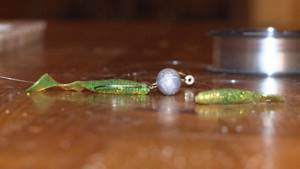
Preferred baits are edible silicone:
- active plastic, rubber worms;
- slugs;
- lizards;
- krakozyabry.
Many fishermen use edible rubber, because the predator holds it in its mouth for a long time and does not spit it out. The fisherman gains time to make the hook in a timely manner.
Pike, pike perch, and perch go well with rubber. The material is attractive because it affects the sense of smell, taste, and vision. If the predator is mobile, then you can use silicone twisters, which is what many spinning anglers do to quickly fish an area.
Additional Information!
Many silicone baits are suitable for Carolina rigs and are attached to a regular or offset hook. It is the installation of fish food on offset machines that allows you to catch predators in algae or polluted places. The size of the bait should be selected taking into account the degree of activity and type of fish. The optimal length for pike and pike perch is over 5 cm. For perch - up to 5 cm.
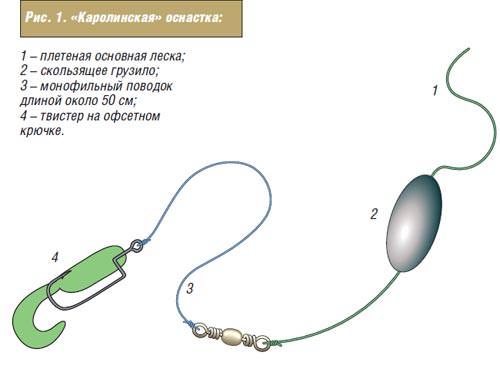
One of the main techniques of the Carolina rig is dragging along the bottom. In this case, it is better to fish for live bait, meat, shellfish using single, double or triple hooks.
For long baits, it is ideal to use offset baits, for example, Texas hook. For volumetric ones - Wide Gap.
For passive fish, a floating bait works effectively; it will follow the sinker at a certain distance from the bottom and float up periodically to attack the predator.
Carolina rig with foam fish
Fishing with a Carolina rig, where instead of a silicone worm or twister, the most ordinary foam rubber is installed, is very interesting. The main thing here is to install the hooks in the foam rubber in such a way that this type of bait can be made into a non-snagging bait. This is achieved by pressing the hooks against the body of the bait.
The wiring method is still the same: twitching and pausing, jigging, dragging along the bottom, sharp jerks. With all this, the foam fish will always strive upward. In this sense, Carolina is interesting because you can tempt very sluggish fish to attack. That is, making only short oscillatory movements, the sinker will travel up to 30-50 centimeters of distance at the bottom in one jerk of the spinning rod, and the foam rubber, in turn, is tempting to play at the bottom without completely falling to the bottom.
Manufacturing of equipment
To increase catchability, it is better to assemble equipment taking into account the catch of a specific predator.
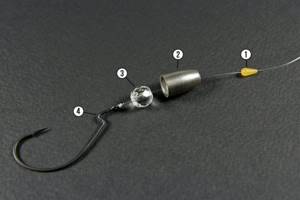
The easiest way that beginners can do:
- Place the sinker on the main line and pass the bead through.
- Tie the swivel with the “Palomar” pattern, then attach a leash with a hook to the swivel. Ideally, use fluorocarbon line 0.5-1.3 m long.
- Tie the leash and hook with a “Double Clinch” knot.
- Place the bait on an offset hook.
- Hide the sting of the body.
If you decide to fish in rocky areas or shell rocks, then in order to avoid breaks, you should tie the sinker to a separate leash made of fluorocarbon fishing line 35 cm long. The breaking load of the auxiliary fishing line should be less than that of the main fishing line.
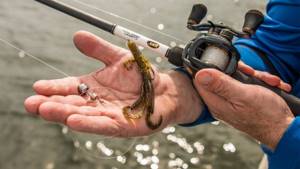
Worth knowing!
Instead of a bead, you can string 2 pieces of cambrics onto a fishing line, placing them between the sinker and the swivel. They will act as anti-twist. When fishing for pike, you should tie a metal leader to fluorocarbon or use thick fluorocarbon with a diameter of 0.3 mm or more to increase the number of bites.
The best hooks for pike are offset (No. 3/0-5/0), for pike perch - 1/0-3/0 with a fluorocarbon leash length of more than 50 cm. For striped perch with well-developed vision, the leash should be longer - up to 1 meters. Manufacturing material: fluorocarbon, thin monofilament. The hook must match the size of the bait and the perch.
Installation of Carolina equipment
So, in our hands we have an unequipped end of a fishing line or cord. The first thing we will mount on it according to the “Carolina” technology is a sinker.
Sinker
According to the standard American system, as we have already said, the shape of the sinker should be bullet-shaped. However, our fishermen often neglect this issue and install simple “olives”, declaring that they do not notice the direct influence of the shape of the sinker on the catchability of the equipment.

As for the material of the sinker, there are three most famous ones for this type of equipment: lead, brass and tungsten. This issue is worth understanding in more detail.
Lead. This is the most common material and at the same time the most inexpensive. Most fishermen use it in almost any conditions: even grass, even driftwood, even stones.
Brass. The sinker, made of brass, according to the Americans, gives that very click on the bead, which attracts a predator from a very long distance. But there is a small nuance here - a brass sinker is significantly lighter than a lead one, which means it is suitable for fishing in relatively shallow reservoirs without a significant current.
Tungsten. A sinker made from this material is ideal for this type of equipment. It has many advantages: significant weight, small volume, flies well, “knocks” perfectly on stones and shells. However, it has one drawback - it cannot always be found in our fishing stores.
Bead
Next “on the list” for the “Carolina rig” is a bead, for which the Americans have two main requirements: high resistance to shock loads and an acoustic effect.

During the casting process, the load will constantly hit the bead with varying force, so it must be highly resistant to shock loads. Otherwise, the bead may simply fall apart after a couple of hits, and this is a waste of precious time for re-equipment.
The acoustic effect is only important if the sinker was chosen from brass. Let us remind you that Americans recommend using beads in combination with brass. But as for our domestic fishermen, their opinion is radically different from their American colleagues. According to Russian fishermen, the presence of a bead is not necessary. The acoustic effect is a fiction, and the shock-absorbing, saving swivel is superfluous. No one will make so many casts that the bullet will break the knot or wear out the line. Much faster, the fisherman will catch the hook, with the subsequent separation of the bait.
Swivel
There are no supernatural requirements for this element, the most important thing is that it is strong, reliable and rotates freely and does not allow the bait to twist the leash.
Leash
After the swivel there is such an element of the “Carolina rig” as a leash. Recently, most fishermen use fluorocarbon line for this element. The length of the leash is determined primarily by the activity of the fish and fishing conditions. Most often it is 0.7 - 1.3 m. By the way, some fishermen notice that the more passive the predator, the longer the leash should be.
As for the diameter of the leash, there is one nuance - this is the breaking load. It should be smaller than that of the main fishing line or cord. When hooked, only the bait will come off, and not the entire set, along with the bullet.
Hook
“Carolina rig” was invented for reservoirs where increased cross-country ability and non-catching bait are the main factors. This means that the hooks most often found in this equipment are offset ones.
Bait
Traditional Carolina rig baits include a variety of active and passive plastic worms.

Most fishermen also advise using only edible rubber in this matter. The thing is that a predator can pick up bait from the bottom unnoticed by us, and we can’t always feel it. Therefore, the use of “edible” helps us out a lot, because the predator does not immediately spit out the bait, but keeps it longer in its mouth. And this is already a good chance to feel the poke and hook the fish.
Fishing technique and tactics
Selecting the optimal wiring is directly on the pond. As you fish, find out at what speed or improvisation the bites will begin one after another and the predator will react.
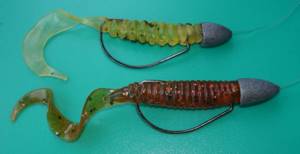
Effective wiring options:
- Stepped . Several turns of the fishing line are made. Then there is a pause until the wiring falls to the bottom.
- Uniform , in which it is worth turning the wiring at the same speed.
- Ryvkova . The bait must be sharply torn off the bottom, then reeled in and paused.
- Pulling the fishing rod at a speed of 15 cm/sec so that the sinker drags along the bottom. Stretch this way up to 100 cm. Pause for 2-6 seconds, playing with the tip of the rod.
- Slow dragging of the load along the bottom with periodic short sharp jerks. Between them pauses are made, varying in pause length. This chaotic option is suitable for stepped twitching wave-like wiring.
- Jig step when fishing in still water. The tackle is pulled up or thrown so that the load touches the bottom and lies there motionless. The bait will move along the trajectory of the load, but in a loose, not tensioned leash.
- Playing in one place using a Carolina rig in the current. If you pull the line, the bait will be carried downstream by the flow of water. When it rolls down, you can tug the tip of the spinning rod and lift it, bringing it closer to you. Then send it down again. The main thing is that the sinker lies motionless at the bottom.
Reference!
The equipment works flawlessly on different wiring options. An effective method for the Americans is the classic dragging of the bait along the bottom. Although the equipment should be selected taking into account the current in the reservoir. For example, the average current will pull the leash, make the bait oscillate and provoke the predator to attack.
How to fish with a Carolina rig: casting, retrieving technique, fishing on the river and in calm water
The Carolina rig is especially effective on reservoirs without current and in slow currents. It is in such conditions that Carolina shows itself at its best, allowing you to animate the bait as lazily as possible, dragging it along the bottom and playing along with the tip of the rod.
In holes and their entrances, on deep slopes, on edges, sharp and smooth changes in depth, you can work the bottom efficiently if you choose the right load. In such places, pike and large perch often lie in ambush behind underwater vegetation or snags.
For pike, the basic wiring of the Carolina fish works - uniform dragging with pauses and accelerations. Perch responds well to all sorts of tweaked animation motifs.
And, of course, when fishing for pike perch and perch on a rocky pebble bottom strewn with shell rock, the Carolina rig has no equal. Animation - uniform dragging along the bottom with pauses, a wavy step, uniform dragging with the tip of the form.
On a current, unlike a regular jig, a good result is achieved by casting across and into the current, so that the bait is dragged toward itself. The weight of the bullet is selected in such a way that when retrieving the bait, it will not be squeezed to the surface, but will go along the bottom.
It should be noted that in strong currents it will be more effective to use a diversion leash or texas.
Catching perch with a Carolina rig:
Tips and tricks
You can't rush the Carolina rig. To be successful in fishing, fishing must be slow and even.
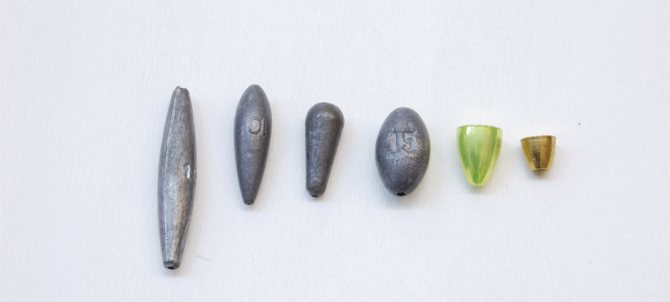
Experienced fishermen advise:
- To increase the acoustic effect, it is worth placing 2 beads on the rig at once.
- If the bites are empty and the predator periodically hits the bead with its tail, then it is recommended to install a rubber stopper.
- If the bite is weak in still water, you can take long pauses. The main thing is that the bait lies completely on the bottom.
- It happens that predatory fish take well silicone fish and edible rubber simply lying motionless on stones or ground.
Carolina rig is a simple type of bait installation. It is best to use it in spring, early summer. At this time, the predator is inactive and takes better lead rigs from the day of the reservoir, in contrast to jig wiring. To improve performance, beginners are advised to re-tie their tackle more often and not be afraid to use new fishing styles.
With frequent contact with water, the tackle can quickly tear. That is why it is always better to bandage it than to lose it on fish.
You need to prepare the equipment in advance. This way you won’t have to waste time tying knots in the pond before fishing.
Carolina rig - tips from fishermen
Alexander Pykhteev (Apostle):
-I use the “Carolina rig” often, usually in the spring and early summer. The predator is still inactive, and is more willing to take lead rigs than jigs. I use it at sea from the shore, on the river during high water, throwing the bait along the bushes. My method of installing such equipment is simple: a lead sinker, a leash - flurry from 30 cm to 1 m depending on the place and conditions, and a bead under the sinker is required so that it protects the knot. As for bait, I always have various crustaceans, crocus, and leeches in my box. One of my favorites is a balltail from a famous Korean brand.
My wiring methods are simple. This is dragging with long pauses, twitching while dragging, and light pumping while pausing.
Vadim Marochkin (Altezz):
-I use “Carolina equipment” in cases where it is needed. This, of course, is targeted fishing for perch in reservoirs with an overgrown bottom, first of all, and in general in any place where you want to catch perch. It is more necessary to look specifically at the local area where you are going to fish. In the same place today, a perch can “eat” a Carolina fish, but tomorrow it will not show any interest in it.
As for the “Carolina equipment” of my recipe, I take the most ordinary bullets for it, most often Tula - they are conveniently packaged and are available in almost every store. As a leash, I won’t be original, I use fluorocarbon. I have it left over from packages of Japanese cords - a little fluor is included with the braid. I was lucky, I got the right diameters. The length of the leash is more complicated here, sometimes the perch needs more freedom of the bait - then you have to put a meter - a little more, and sometimes half a meter of the leash is enough. Bead... Sometimes I put it on, sometimes I don’t - it depends on my memory. If I remember, I’ll install it, if I don’t remember, I’ll do without it.
As far as baits go, I like anything that has a tail. Or some other feature of the end of the bait - for example, a ball, like the Aiko Balltail. All kinds of creative baits, krakozyabrs and so on. I don’t use classic twisters and vibrating tails.
Carolina fishing often takes place in close contact with stones and abrasive, you have to often re-tie so as not to lose the bait when a perch bites or something else - so I’m not particularly worried that a bullet will break the knot on the braid.
With wiring it’s not so simple either; you have to change it often. Personally, what works for me most often is evil wiring, literally hitting the cord with a spinning rod - the bait moves sharply and chaotically along the bottom. But sometimes you have to switch to careful and slow pulls - this is how the perch is tuned.
I would like to advise novice fishermen not to be afraid of new fishing styles and to re-tie the tackle more often! As I already said, the line is constantly in contact with the bottom and moves quickly - don’t be lazy, it’s better to tie the tackle yourself than to lose it on the fish!
Dimitry Pankin(Admin):
-Like most fishermen in our region, I use the “Carolina rig” when purposefully catching perch, when it does not respond to a classic jig or nibbles the bait by the tail and it is almost impossible to detect it.
Of the secrets of fishing with the Carolina rig, I’m ready to share two. Firstly, it is preparing gear in advance. I prepare several rigs at once so that I can spend a minimum of time when tearing them off. Secondly, it is a quick conversion of a conventional jig bait with a steel leader to a Carolina lure. This is necessary if bites on a jig do not bring results, and you decide to re-equip yourself with a Carolina jig. To do this, remove the jig bait, unwind the loop of the steel leash from the free side, put on the bullet, and attach the Carolina swivel to the leash, that’s it, half a minute and the “Carolina rig” is ready. No need to waste time tying knots.
Perch - how to catch
Perch is a predator. To catch a perch, especially a large one, you need to try, but this effort can be rewarded. Here we will talk in detail about perch fishing.
Perch , now it’s time to talk about one of the most famous fish, which geographically inhabits almost all water bodies of the country, lives in lakes and rivers, which is a coveted trophy among professional and experienced fishermen, and which “opens” the doors to the world of fishing for beginners young fishermen. Like some other types of fish, perch has been familiar to us since childhood. It is the perch that is often depicted in children's books, but having matured a little, the boys go to the nearest river or pond, and most likely, it is the perch that is the first trophy, the first fish that they managed to catch on their own.
In this section, we will not talk about dishes that can be prepared from perch, since there are so many of them that it is simply unrealistic to list and remember everything (we will tell you here). But it just so happens that perch makes good fish soup, and when fried it is a real masterpiece. We will try to give some description of this fish, briefly talk about the favorite places for this fish to stop, and actually give brief data on perch fishing. Naturally, all the nuances cannot be revealed in one article, especially when it comes to perch, since there are so many methods for fishing for this fish today that each of them is worthy of its own separate description and review, which you will find below.
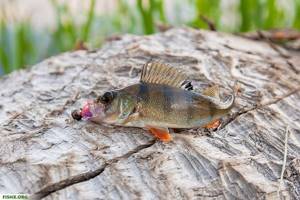
Externally, perch cannot be confused with any other fish. Perch has small scales, the gills are somewhat pointed at the rear end, which is important to take into account when fishing in order to avoid injury. The main distinguishing feature of a perch is its color and a sharp, spine-studded upper fin, which can also cause injury to an inexperienced fisherman. Elongated stripes are noticeable along the body of the perch, giving the perch a “zebra-shaped” appearance; the remaining fins are reddish-orange in color. If you look at the perch from above, the main color will be greenish-gray, with a blackish tint, but when viewed from below, a whitish-yellow tint will appear. Look at the photo, is it possible to confuse perch with any other fish?
Finding a fishing spot
In spring, schools of perch concentrate in flooded snags and in sections of the river with a reverse flow. Such places where predators gather are detected visually when striped robbers hunt fry.
- When fishing on a river, the fisherman should first determine the main stream of the current. Typically, the strongest flow is observed in the middle of the reservoir, and weakens as it approaches land. That is why it is best for a fisherman to use search tactics, moving along the coastline and throwing tackle at promising points.
- When casting a fishing rod, it is important to set the fishing depth correctly. This primarily concerns lovers of float and live bait gear. Spinning fishermen should select artificial baits in such a way that they can pass near the bottom when reeling slowly. Attacks by striped robbers in the middle and upper layers of water are very rare. Even when small fish jump out to the surface of the water area, the perch still bites from the bottom.
- Perch sites do not always coincide with the aspirations of anglers. The predator finds enough secluded places on the clogged bottom, where many snags of equipment occur. To successfully remove hooks and lures, it is useful to have a release hook in your fishing box.
- The ideal area for fishing for spring perch is a small bay with medium depth, which is surrounded by bushes. Small striped predators hunt near land, and larger individuals should be looked for at a distance of 8-10 m from the coastline.
- Cliffs will be promising places for catching perch. The front channel edge forms a slope that runs along the shore for a long distance. Particularly interesting are points with the presence of snags and boulders. You should throw the rig behind the stall line, and then slowly perform the retrieve.
During active feeding of perch, spinning rod becomes the most productive gear. Almost every cast ends with a bite from a predator. Assembling a spinning rod for catching striped robber is quite simple.
